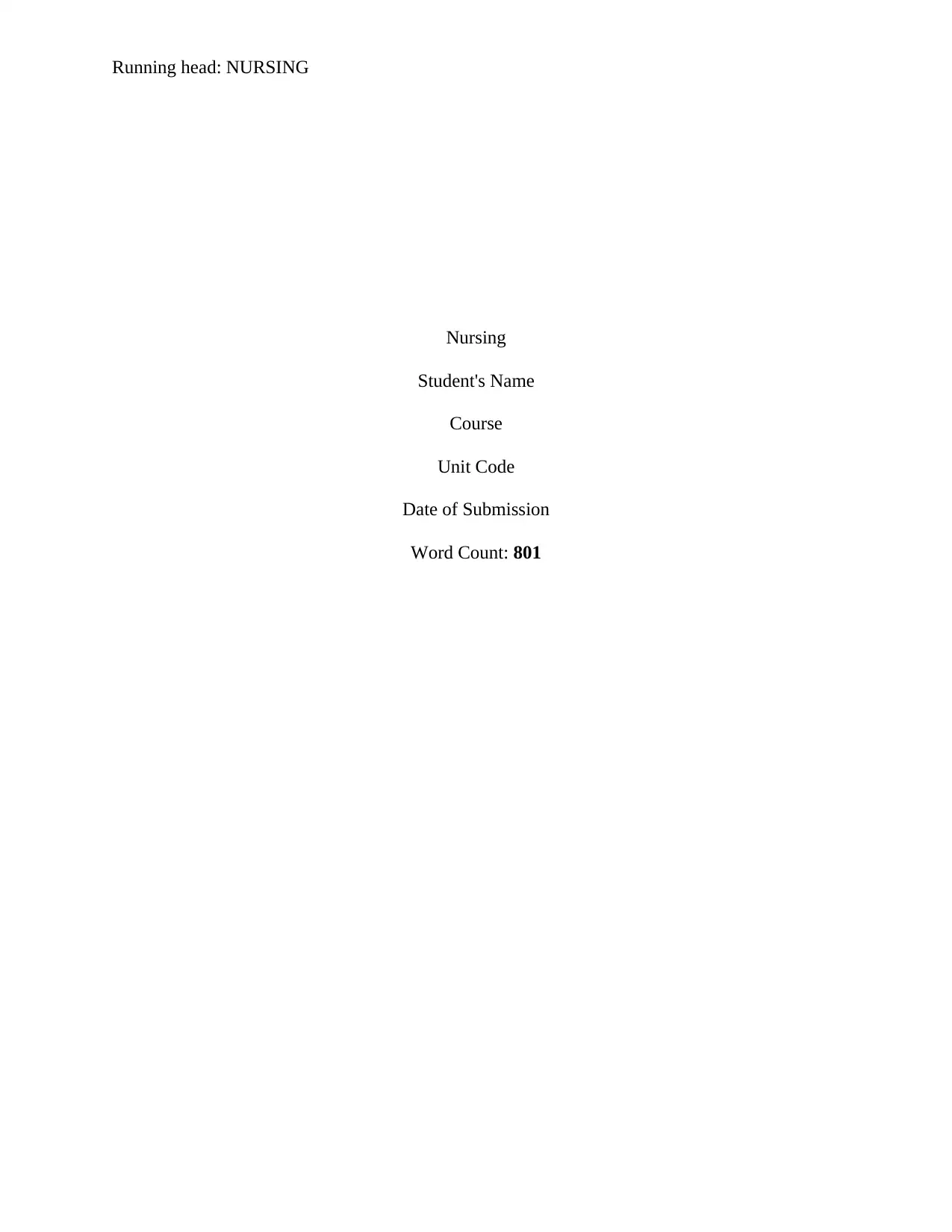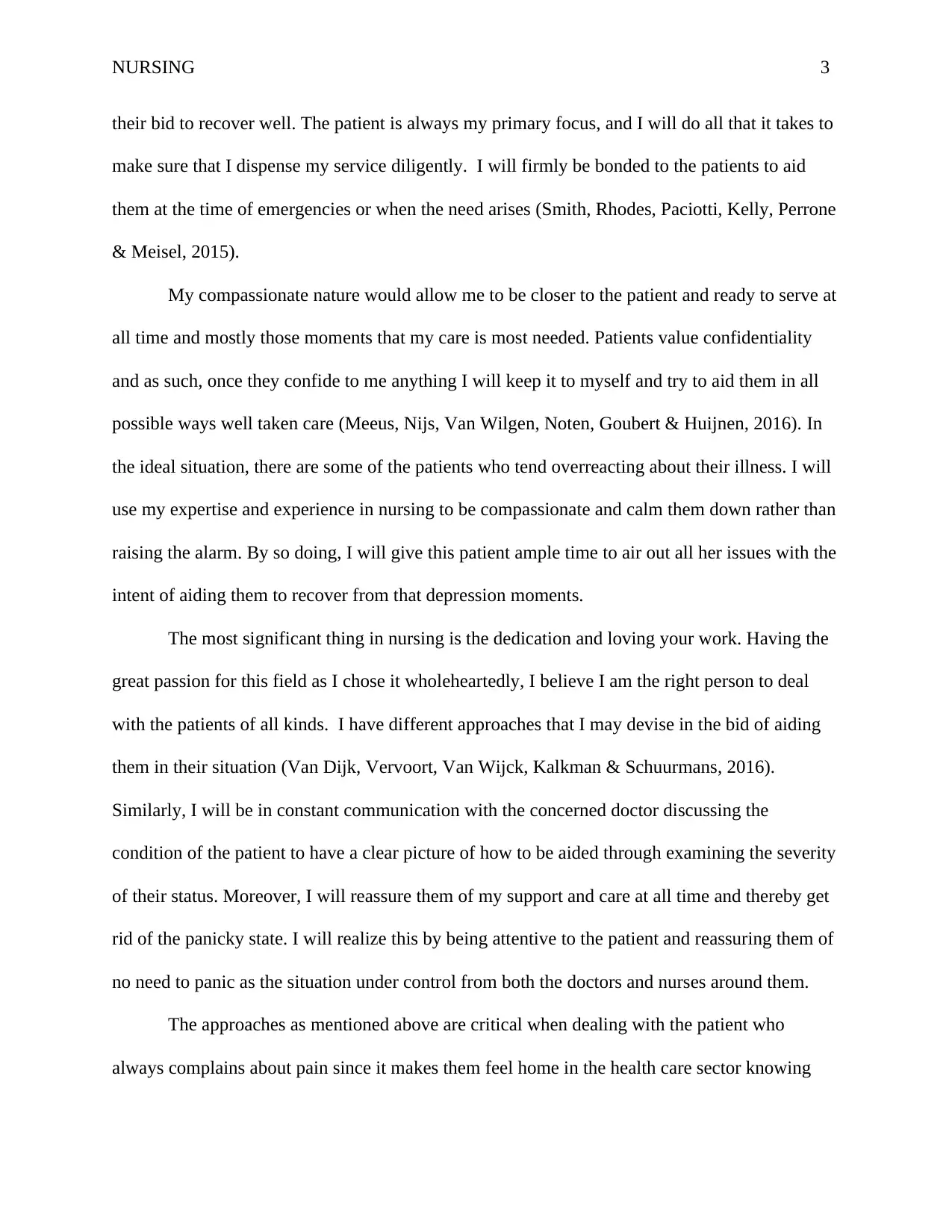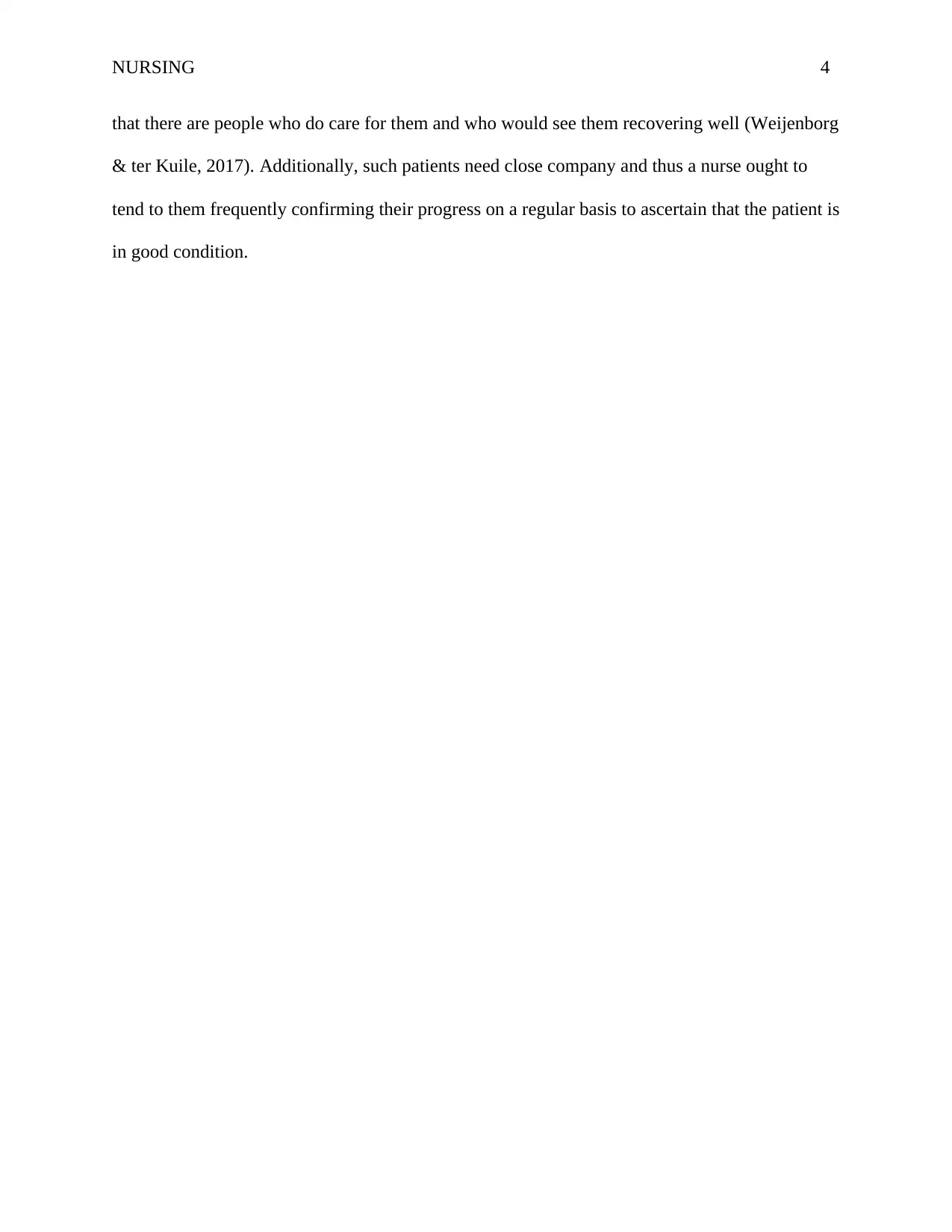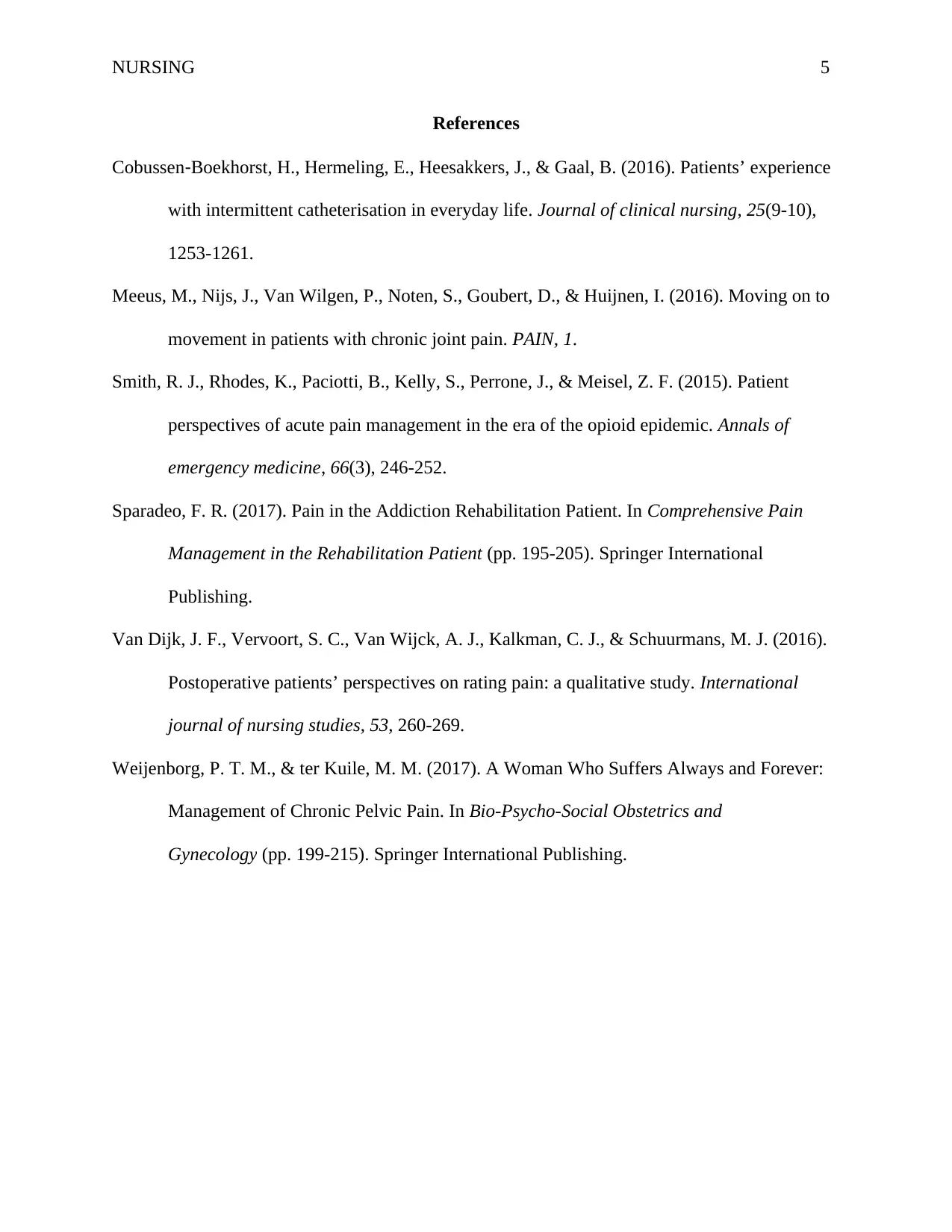Nursing Report: Effective Strategies for Patient Pain Management
VerifiedAdded on 2020/03/04
|5
|1181
|82
Report
AI Summary
This nursing report focuses on effective strategies for handling patients who consistently express pain. The author, a nursing student, emphasizes the importance of compassionate care, building rapport, and employing the "R's of Responding." The report outlines the nurse's values, including a commitment to patient well-being, ethical conduct, and personalized attention. The student nurse highlights the need for open communication, confidentiality, and collaboration with doctors. The report also discusses how to manage patients' emotional responses to pain, ensuring they feel supported and understood. References to supporting literature are included, emphasizing the importance of dedication, communication, and a patient-centered approach in nursing practice.

Running head: NURSING
Nursing
Student's Name
Course
Unit Code
Date of Submission
Word Count: 801
Nursing
Student's Name
Course
Unit Code
Date of Submission
Word Count: 801
Paraphrase This Document
Need a fresh take? Get an instant paraphrase of this document with our AI Paraphraser

NURSING 2
How would you handle a patient who always complains about pain?
Caring is an essential part of nursing, and this is the primary reason why most of the
managers would prefer to hear from the applicant how they are prepared to handle and take care
of the patient and as thus the manager who is also the interviewer can evaluate the attitude of the
nurse towards the patients. Therefore, I believe my presentation will matter a lot to the panelist,
and thus these are some of the things that were going to put into consideration. For such case, I
will employ Bain’s R’s of Responding, Reporting, Relating, Reasoning and Reconstructing as
explicated in this work. I will talk about my values; this includes critical description of my
personality and my attitude towards the patients. I am always passionate and have the desire to
effect positive changes in the patient’s life. Some of the incredible values that I do possess is
being passionate in taking good care of the patient (Sparadeo, 2017). My positive attitude to the
patients is also in tandem with my vision of moving along with the patient to know how they are
faring on even after being discharged from the hospital. I will always stick to the set regulation
and code of ethics that centers on my progression by ng myself in a professionally carrying
myself and the one which is readily available to attend to the patients at any time of the day.
Moreover, I would create a friendly environment where I would be able to attend to them
by giving the patients the necessary care that they deserve. On the same note, these patients need
personalized attention and thus will be available at all times to get their views and able to handle
them healthily. It is incumbent to note that most patient does prefer someone who would lend
them their ears to realize some of the interesting issues that are of much concern to their lives
(Cobussen‐Boekhorst, Hermeling, Heesakkers & Gaal, 2016). I will give my patient ample time
and try to build the proper rapport with the patients for them to feel affiliated and get that
opportunity to disclose some of the issues that psychologically disturbs and thereby inhibiting
How would you handle a patient who always complains about pain?
Caring is an essential part of nursing, and this is the primary reason why most of the
managers would prefer to hear from the applicant how they are prepared to handle and take care
of the patient and as thus the manager who is also the interviewer can evaluate the attitude of the
nurse towards the patients. Therefore, I believe my presentation will matter a lot to the panelist,
and thus these are some of the things that were going to put into consideration. For such case, I
will employ Bain’s R’s of Responding, Reporting, Relating, Reasoning and Reconstructing as
explicated in this work. I will talk about my values; this includes critical description of my
personality and my attitude towards the patients. I am always passionate and have the desire to
effect positive changes in the patient’s life. Some of the incredible values that I do possess is
being passionate in taking good care of the patient (Sparadeo, 2017). My positive attitude to the
patients is also in tandem with my vision of moving along with the patient to know how they are
faring on even after being discharged from the hospital. I will always stick to the set regulation
and code of ethics that centers on my progression by ng myself in a professionally carrying
myself and the one which is readily available to attend to the patients at any time of the day.
Moreover, I would create a friendly environment where I would be able to attend to them
by giving the patients the necessary care that they deserve. On the same note, these patients need
personalized attention and thus will be available at all times to get their views and able to handle
them healthily. It is incumbent to note that most patient does prefer someone who would lend
them their ears to realize some of the interesting issues that are of much concern to their lives
(Cobussen‐Boekhorst, Hermeling, Heesakkers & Gaal, 2016). I will give my patient ample time
and try to build the proper rapport with the patients for them to feel affiliated and get that
opportunity to disclose some of the issues that psychologically disturbs and thereby inhibiting

NURSING 3
their bid to recover well. The patient is always my primary focus, and I will do all that it takes to
make sure that I dispense my service diligently. I will firmly be bonded to the patients to aid
them at the time of emergencies or when the need arises (Smith, Rhodes, Paciotti, Kelly, Perrone
& Meisel, 2015).
My compassionate nature would allow me to be closer to the patient and ready to serve at
all time and mostly those moments that my care is most needed. Patients value confidentiality
and as such, once they confide to me anything I will keep it to myself and try to aid them in all
possible ways well taken care (Meeus, Nijs, Van Wilgen, Noten, Goubert & Huijnen, 2016). In
the ideal situation, there are some of the patients who tend overreacting about their illness. I will
use my expertise and experience in nursing to be compassionate and calm them down rather than
raising the alarm. By so doing, I will give this patient ample time to air out all her issues with the
intent of aiding them to recover from that depression moments.
The most significant thing in nursing is the dedication and loving your work. Having the
great passion for this field as I chose it wholeheartedly, I believe I am the right person to deal
with the patients of all kinds. I have different approaches that I may devise in the bid of aiding
them in their situation (Van Dijk, Vervoort, Van Wijck, Kalkman & Schuurmans, 2016).
Similarly, I will be in constant communication with the concerned doctor discussing the
condition of the patient to have a clear picture of how to be aided through examining the severity
of their status. Moreover, I will reassure them of my support and care at all time and thereby get
rid of the panicky state. I will realize this by being attentive to the patient and reassuring them of
no need to panic as the situation under control from both the doctors and nurses around them.
The approaches as mentioned above are critical when dealing with the patient who
always complains about pain since it makes them feel home in the health care sector knowing
their bid to recover well. The patient is always my primary focus, and I will do all that it takes to
make sure that I dispense my service diligently. I will firmly be bonded to the patients to aid
them at the time of emergencies or when the need arises (Smith, Rhodes, Paciotti, Kelly, Perrone
& Meisel, 2015).
My compassionate nature would allow me to be closer to the patient and ready to serve at
all time and mostly those moments that my care is most needed. Patients value confidentiality
and as such, once they confide to me anything I will keep it to myself and try to aid them in all
possible ways well taken care (Meeus, Nijs, Van Wilgen, Noten, Goubert & Huijnen, 2016). In
the ideal situation, there are some of the patients who tend overreacting about their illness. I will
use my expertise and experience in nursing to be compassionate and calm them down rather than
raising the alarm. By so doing, I will give this patient ample time to air out all her issues with the
intent of aiding them to recover from that depression moments.
The most significant thing in nursing is the dedication and loving your work. Having the
great passion for this field as I chose it wholeheartedly, I believe I am the right person to deal
with the patients of all kinds. I have different approaches that I may devise in the bid of aiding
them in their situation (Van Dijk, Vervoort, Van Wijck, Kalkman & Schuurmans, 2016).
Similarly, I will be in constant communication with the concerned doctor discussing the
condition of the patient to have a clear picture of how to be aided through examining the severity
of their status. Moreover, I will reassure them of my support and care at all time and thereby get
rid of the panicky state. I will realize this by being attentive to the patient and reassuring them of
no need to panic as the situation under control from both the doctors and nurses around them.
The approaches as mentioned above are critical when dealing with the patient who
always complains about pain since it makes them feel home in the health care sector knowing
⊘ This is a preview!⊘
Do you want full access?
Subscribe today to unlock all pages.

Trusted by 1+ million students worldwide

NURSING 4
that there are people who do care for them and who would see them recovering well (Weijenborg
& ter Kuile, 2017). Additionally, such patients need close company and thus a nurse ought to
tend to them frequently confirming their progress on a regular basis to ascertain that the patient is
in good condition.
that there are people who do care for them and who would see them recovering well (Weijenborg
& ter Kuile, 2017). Additionally, such patients need close company and thus a nurse ought to
tend to them frequently confirming their progress on a regular basis to ascertain that the patient is
in good condition.
Paraphrase This Document
Need a fresh take? Get an instant paraphrase of this document with our AI Paraphraser

NURSING 5
References
Cobussen‐Boekhorst, H., Hermeling, E., Heesakkers, J., & Gaal, B. (2016). Patients’ experience
with intermittent catheterisation in everyday life. Journal of clinical nursing, 25(9-10),
1253-1261.
Meeus, M., Nijs, J., Van Wilgen, P., Noten, S., Goubert, D., & Huijnen, I. (2016). Moving on to
movement in patients with chronic joint pain. PAIN, 1.
Smith, R. J., Rhodes, K., Paciotti, B., Kelly, S., Perrone, J., & Meisel, Z. F. (2015). Patient
perspectives of acute pain management in the era of the opioid epidemic. Annals of
emergency medicine, 66(3), 246-252.
Sparadeo, F. R. (2017). Pain in the Addiction Rehabilitation Patient. In Comprehensive Pain
Management in the Rehabilitation Patient (pp. 195-205). Springer International
Publishing.
Van Dijk, J. F., Vervoort, S. C., Van Wijck, A. J., Kalkman, C. J., & Schuurmans, M. J. (2016).
Postoperative patients’ perspectives on rating pain: a qualitative study. International
journal of nursing studies, 53, 260-269.
Weijenborg, P. T. M., & ter Kuile, M. M. (2017). A Woman Who Suffers Always and Forever:
Management of Chronic Pelvic Pain. In Bio-Psycho-Social Obstetrics and
Gynecology (pp. 199-215). Springer International Publishing.
References
Cobussen‐Boekhorst, H., Hermeling, E., Heesakkers, J., & Gaal, B. (2016). Patients’ experience
with intermittent catheterisation in everyday life. Journal of clinical nursing, 25(9-10),
1253-1261.
Meeus, M., Nijs, J., Van Wilgen, P., Noten, S., Goubert, D., & Huijnen, I. (2016). Moving on to
movement in patients with chronic joint pain. PAIN, 1.
Smith, R. J., Rhodes, K., Paciotti, B., Kelly, S., Perrone, J., & Meisel, Z. F. (2015). Patient
perspectives of acute pain management in the era of the opioid epidemic. Annals of
emergency medicine, 66(3), 246-252.
Sparadeo, F. R. (2017). Pain in the Addiction Rehabilitation Patient. In Comprehensive Pain
Management in the Rehabilitation Patient (pp. 195-205). Springer International
Publishing.
Van Dijk, J. F., Vervoort, S. C., Van Wijck, A. J., Kalkman, C. J., & Schuurmans, M. J. (2016).
Postoperative patients’ perspectives on rating pain: a qualitative study. International
journal of nursing studies, 53, 260-269.
Weijenborg, P. T. M., & ter Kuile, M. M. (2017). A Woman Who Suffers Always and Forever:
Management of Chronic Pelvic Pain. In Bio-Psycho-Social Obstetrics and
Gynecology (pp. 199-215). Springer International Publishing.
1 out of 5
Related Documents
Your All-in-One AI-Powered Toolkit for Academic Success.
+13062052269
info@desklib.com
Available 24*7 on WhatsApp / Email
![[object Object]](/_next/static/media/star-bottom.7253800d.svg)
Unlock your academic potential
Copyright © 2020–2025 A2Z Services. All Rights Reserved. Developed and managed by ZUCOL.




